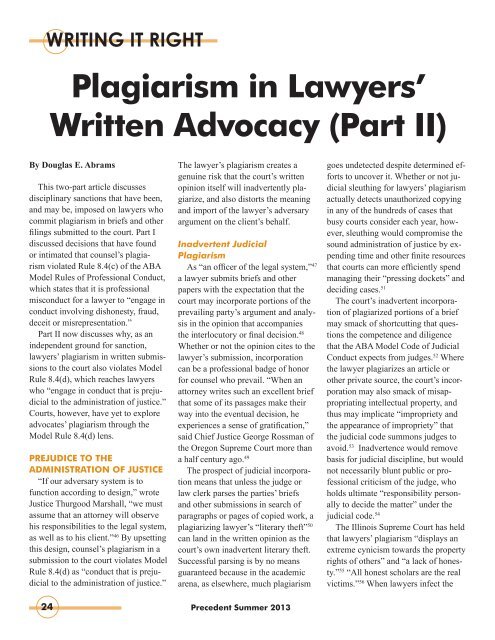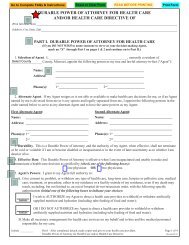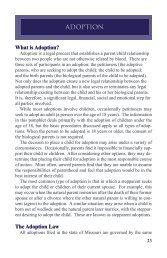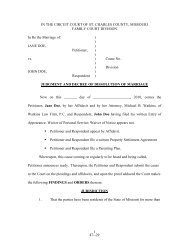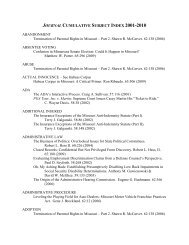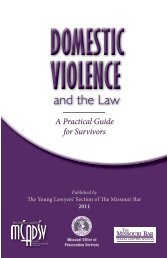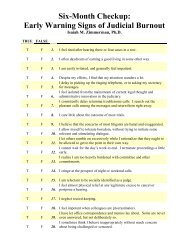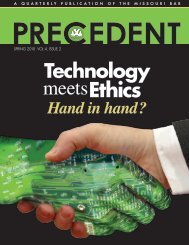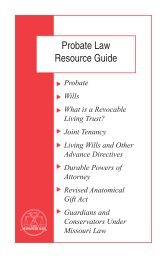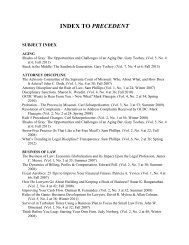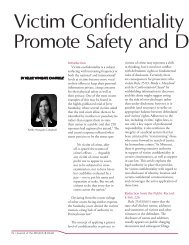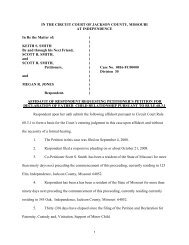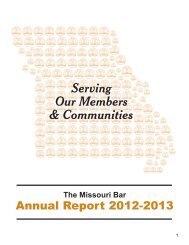Plagiarism in Lawyers' Written Advocacy (Part II) - the Missouri Bar
Plagiarism in Lawyers' Written Advocacy (Part II) - the Missouri Bar
Plagiarism in Lawyers' Written Advocacy (Part II) - the Missouri Bar
Create successful ePaper yourself
Turn your PDF publications into a flip-book with our unique Google optimized e-Paper software.
WRITING IT RIGHT<strong>Plagiarism</strong> <strong>in</strong> Lawyers’<strong>Written</strong> <strong>Advocacy</strong> (<strong>Part</strong> <strong>II</strong>)By Douglas E. AbramsThis two-part article discussesdiscipl<strong>in</strong>ary sanctions that have been,and may be, imposed on lawyers whocommit plagiarism <strong>in</strong> briefs and o<strong>the</strong>rfil<strong>in</strong>gs submitted to <strong>the</strong> court. <strong>Part</strong> Idiscussed decisions that have foundor <strong>in</strong>timated that counsel’s plagiarismviolated Rule 8.4(c) of <strong>the</strong> ABAModel Rules of Professional Conduct,which states that it is professionalmisconduct for a lawyer to “engage <strong>in</strong>conduct <strong>in</strong>volv<strong>in</strong>g dishonesty, fraud,deceit or misrepresentation.”<strong>Part</strong> <strong>II</strong> now discusses why, as an<strong>in</strong>dependent ground for sanction,lawyers’ plagiarism <strong>in</strong> written submissionsto <strong>the</strong> court also violates ModelRule 8.4(d), which reaches lawyerswho “engage <strong>in</strong> conduct that is prejudicialto <strong>the</strong> adm<strong>in</strong>istration of justice.”Courts, however, have yet to exploreadvocates’ plagiarism through <strong>the</strong>Model Rule 8.4(d) lens.PREJUDICE TO THEADMINISTRATION OF JUSTICE“If our adversary system is tofunction accord<strong>in</strong>g to design,” wroteJustice Thurgood Marshall, “we mustassume that an attorney will observehis responsibilities to <strong>the</strong> legal system,as well as to his client.” 46 By upsett<strong>in</strong>gthis design, counsel’s plagiarism <strong>in</strong> asubmission to <strong>the</strong> court violates ModelRule 8.4(d) as “conduct that is prejudicialto <strong>the</strong> adm<strong>in</strong>istration of justice.”24The lawyer’s plagiarism creates agenu<strong>in</strong>e risk that <strong>the</strong> court’s writtenop<strong>in</strong>ion itself will <strong>in</strong>advertently plagiarize,and also distorts <strong>the</strong> mean<strong>in</strong>gand import of <strong>the</strong> lawyer’s adversaryargument on <strong>the</strong> client’s behalf.Inadvertent Judicial<strong>Plagiarism</strong>As “an officer of <strong>the</strong> legal system,” 47a lawyer submits briefs and o<strong>the</strong>rpapers with <strong>the</strong> expectation that <strong>the</strong>court may <strong>in</strong>corporate portions of <strong>the</strong>prevail<strong>in</strong>g party’s argument and analysis<strong>in</strong> <strong>the</strong> op<strong>in</strong>ion that accompanies<strong>the</strong> <strong>in</strong>terlocutory or f<strong>in</strong>al decision. 48Whe<strong>the</strong>r or not <strong>the</strong> op<strong>in</strong>ion cites to <strong>the</strong>lawyer’s submission, <strong>in</strong>corporationcan be a professional badge of honorfor counsel who prevail. “When anattorney writes such an excellent briefthat some of its passages make <strong>the</strong>irway <strong>in</strong>to <strong>the</strong> eventual decision, heexperiences a sense of gratification,”said Chief Justice George Rossman of<strong>the</strong> Oregon Supreme Court more thana half century ago. 49The prospect of judicial <strong>in</strong>corporationmeans that unless <strong>the</strong> judge orlaw clerk parses <strong>the</strong> parties’ briefsand o<strong>the</strong>r submissions <strong>in</strong> search ofparagraphs or pages of copied work, aplagiariz<strong>in</strong>g lawyer’s “literary <strong>the</strong>ft” 50can land <strong>in</strong> <strong>the</strong> written op<strong>in</strong>ion as <strong>the</strong>court’s own <strong>in</strong>advertent literary <strong>the</strong>ft.Successful pars<strong>in</strong>g is by no meansguaranteed because <strong>in</strong> <strong>the</strong> academicarena, as elsewhere, much plagiarismPrecedent Summer 2013goes undetected despite determ<strong>in</strong>ed effortsto uncover it. Whe<strong>the</strong>r or not judicialsleuth<strong>in</strong>g for lawyers’ plagiarismactually detects unauthorized copy<strong>in</strong>g<strong>in</strong> any of <strong>the</strong> hundreds of cases thatbusy courts consider each year, however,sleuth<strong>in</strong>g would compromise <strong>the</strong>sound adm<strong>in</strong>istration of justice by expend<strong>in</strong>gtime and o<strong>the</strong>r f<strong>in</strong>ite resourcesthat courts can more efficiently spendmanag<strong>in</strong>g <strong>the</strong>ir “press<strong>in</strong>g dockets” anddecid<strong>in</strong>g cases. 51The court’s <strong>in</strong>advertent <strong>in</strong>corporationof plagiarized portions of a briefmay smack of shortcutt<strong>in</strong>g that questions<strong>the</strong> competence and diligencethat <strong>the</strong> ABA Model Code of JudicialConduct expects from judges. 52 Where<strong>the</strong> lawyer plagiarizes an article oro<strong>the</strong>r private source, <strong>the</strong> court’s <strong>in</strong>corporationmay also smack of misappropriat<strong>in</strong>g<strong>in</strong>tellectual property, andthus may implicate “impropriety and<strong>the</strong> appearance of impropriety” that<strong>the</strong> judicial code summons judges toavoid. 53 Inadvertence would removebasis for judicial discipl<strong>in</strong>e, but wouldnot necessarily blunt public or professionalcriticism of <strong>the</strong> judge, whoholds ultimate “responsibility personallyto decide <strong>the</strong> matter” under <strong>the</strong>judicial code. 54The Ill<strong>in</strong>ois Supreme Court has heldthat lawyers’ plagiarism “displays anextreme cynicism towards <strong>the</strong> propertyrights of o<strong>the</strong>rs” and “a lack of honesty.”55 “All honest scholars are <strong>the</strong> realvictims.” 56 When lawyers <strong>in</strong>fect <strong>the</strong>
WRITING IT RIGHTproceed<strong>in</strong>g with plagiarism that mayf<strong>in</strong>d its way <strong>in</strong>to <strong>the</strong> court’s op<strong>in</strong>ion,<strong>the</strong>y prejudice <strong>the</strong> adm<strong>in</strong>istration ofjustice because <strong>the</strong> ABA Model Codeof Judicial Conduct summons judgesto “aspire at all times to conduct that<strong>in</strong>sures <strong>the</strong> greatest possible publicconfidence <strong>in</strong> <strong>the</strong>ir . . . <strong>in</strong>tegrity.” 57“Judges hold a position of publictrust,” concludes Chief Justice JohnG. Roberts, Jr., “and <strong>the</strong> public has aright to demand that <strong>the</strong>y adhere to ademand<strong>in</strong>g code of conduct.” 58 At <strong>the</strong>least, this aspiration and public rightcontemplate that judges will meet <strong>the</strong>standards of <strong>in</strong>tegrity that Model Rule8.4 demands from <strong>the</strong> lawyers whoappear before <strong>the</strong>m.Distort<strong>in</strong>g <strong>the</strong> AdversaryArgument“[T]he judicial process [is] at itsbest,” wrote Justice Felix Frankfurter,when courts receive “comprehensivebriefs and powerful arguments onboth sides.” 59 Counsel’s plagiarismcompromises <strong>the</strong> sound adm<strong>in</strong>istrationof justice (and, as Justices Frankfurterand Marshall suggested, may alsoweaken <strong>the</strong> client’s cause) by <strong>in</strong>duc<strong>in</strong>g<strong>the</strong> court to mistake <strong>the</strong> brief’s copiedpassages as products of counsel’s ownpartisan thought processes, ra<strong>the</strong>rthan as an uncompensated non-party’sanalysis presumably helpful to <strong>the</strong>proponent. “[C]ases are won on <strong>the</strong>facts and <strong>the</strong> law,” said Judge John C.Godbold of <strong>the</strong> U.S. Court of Appealsfor <strong>the</strong> 11th Circuit, “not on <strong>the</strong>em<strong>in</strong>ence, polished writ<strong>in</strong>g, oratory, orpersonality of counsel.” 60The three decisions discussed <strong>in</strong><strong>Part</strong> I of this article demonstrate howundetected plagiarism can distort <strong>the</strong>mean<strong>in</strong>g and import of <strong>the</strong> adversaryargument that underlies judicialdecision-mak<strong>in</strong>g. In United Statesv. Bowen, defense counsel sought tooverturn <strong>the</strong> client’s 30-year prisonsentence with a brief that appearedto reflect counsel’s own unadornedargumentation. Counsel would havereduced <strong>the</strong> prospect of judicial errorby candidly <strong>in</strong>form<strong>in</strong>g <strong>the</strong> 6th Circuitpanel that <strong>the</strong> argument rested on <strong>the</strong>earlier op<strong>in</strong>ion of <strong>the</strong> Massachusettsdistrict court, which held constitutionalauthority to hear and decide <strong>the</strong> meritswithout a personal or professionalstake <strong>in</strong> <strong>the</strong> outcome.In In re Burghoff, counsel disserved<strong>the</strong> adm<strong>in</strong>istration of justice by fail<strong>in</strong>gto <strong>in</strong>form <strong>the</strong> bankruptcy court thathis analysis reflected <strong>the</strong> presumablydis<strong>in</strong>terested perspectives of twoprom<strong>in</strong>ent practitioners <strong>in</strong> a lawreview article, or at least by fail<strong>in</strong>gto cite <strong>the</strong> article and <strong>in</strong>vite <strong>the</strong> courtto consider it for whatever value<strong>the</strong> court might ascribe. Similarly,<strong>in</strong> K<strong>in</strong>gvision Pay Per View, Ltd.v. Wilson, counsel overlooked <strong>the</strong>prospect that <strong>the</strong> court might havedeliberated differently if it had knownthat argumentation came from <strong>the</strong>iconic multi-volume Wright-Miller-Cooper federal civil practice treatise,and not from counsel’s own prosecreated on reta<strong>in</strong>er.CONCLUSIONReported decisions call<strong>in</strong>g attentionto lawyers’ plagiarism were rarebefore about 2000. 61 <strong>Plagiarism</strong> today,however, imposes professional embarrassmentwhen <strong>the</strong> list of counsels’ appearancesor <strong>the</strong> court’s op<strong>in</strong>ion itselfidentifies <strong>the</strong> lawyer whose “literary<strong>the</strong>ft” 62 fits so naturally with<strong>in</strong> ModelRule 8.4(c)’s recitation of “conduct<strong>in</strong>volv<strong>in</strong>g dishonesty, fraud, deceit ormisrepresentation.” 63 Even where <strong>the</strong>Precedent Summer 2013court does not recommend a sanctionfor violation, 64 be<strong>in</strong>g labeled aplagiarist <strong>in</strong> <strong>the</strong> bound reporter or onelectronic retrieval is a serious professionalsetback for a lawyer, whosereputation for <strong>in</strong>tegrity is a core personalasset. 65Lawyers’ plagiarism also violatesModel Rule 8.4(d) as “conduct thatis prejudicial to <strong>the</strong> adm<strong>in</strong>istration ofjustice.” 66 Not only does this plagiarismcreate genu<strong>in</strong>e risk of <strong>in</strong>advertentplagiarism by <strong>the</strong> court, but it alsodistorts <strong>the</strong> mean<strong>in</strong>g and import of<strong>the</strong> adversary argument that underliesreasoned decision-mak<strong>in</strong>g.“The process of decid<strong>in</strong>g cases onappeal,” wrote Chief Justice Arthur T.Vanderbilt of <strong>the</strong> New Jersey SupremeCourt, “<strong>in</strong>volves <strong>the</strong> jo<strong>in</strong>t efforts ofcounsel and <strong>the</strong> court. It is only wheneach branch of <strong>the</strong> profession performsits function properly that justice canbe adm<strong>in</strong>istered to <strong>the</strong> satisfaction ofboth <strong>the</strong> litigants and society and abody of decisions developed that willbe a credit to <strong>the</strong> bar, <strong>the</strong> courts and<strong>the</strong> state.” 67ENDNOTES46 Geders v. United States, 425 U.S. 80, 93(1976) (Marshall, J., concurr<strong>in</strong>g).47 ABA Model Rules of Prof’l Conduct,Pmbl. para. [1]; see also, e.g., Goldfarb v. Va.State <strong>Bar</strong>, 421 U.S. 773, 792 (1975)(“[L]awyers are essential to <strong>the</strong> primary governmentalfunction of adm<strong>in</strong>ister<strong>in</strong>g justice,and have historically been ‘officers of <strong>the</strong>courts.’”); Norelus v. Denny’s, Inc., 628 F.3d1270, 1308 (11th Cir. 2010) (“[E]very lawyerserves, not only as an advocate, but as an officerof <strong>the</strong> court.”).48 See, e.g., Herbert F. Goodrich, A Case onAppeal – A Judge’s View, <strong>in</strong> Classic Essays,supra note 49, at 517 (“[S]ome judges lifta portion of <strong>the</strong> successful party’s brief and<strong>in</strong>corporate it <strong>in</strong>to <strong>the</strong> op<strong>in</strong>ion of <strong>the</strong> court.”).49 George Rossman, Appellate Practice and<strong>Advocacy</strong>, 16 F.R.D. 403, 403 (1955).50 Webster’s New Collegiate Dictionary898 (9th ed. 1983).25
WRITING IT RIGHT51 John G. Roberts, Jr., Chief Justice’s2010 Year-End Report on <strong>the</strong> Federal Judiciary4 (discuss<strong>in</strong>g <strong>the</strong> federal courts’ “press<strong>in</strong>gdockets” and efforts to produce “cost sav<strong>in</strong>gs,improved efficiency, and reduced backlogs”),http://www.supremecourt.gov/public<strong>in</strong>fo/yearend/year-endreports.aspx.52 ABA Model Code of Judicial Conduct,R. 2.5 (2010).53 Id., R. 1.2 (2010).54 Id., R. 2.9(A)(3) (2010).55 In re Lamberis, 443 N.W.2d 549, 551-52(Ill. 1982).56 Id. at 552.57 ABA Model Code of Judicial Conduct,pmbl. para. [2] (2010).58 Chief Justice’s 2007 Year-End Report on <strong>the</strong>Federal Judiciary 5, http://www.supremecourt.gov/public<strong>in</strong>fo/year-end/year-endreports.aspx.59 Adamson v. California, 332 U.S. 46, 59(1947) (Frankfurter, J., concurr<strong>in</strong>g).60 John C. Godbold, Twenty Pages andTwenty M<strong>in</strong>utes: Effective <strong>Advocacy</strong> on Appeal,30 Sw. L.J. 801, 808 (1976).61 See, e.g., In re H<strong>in</strong>den, 654 A.2d 864(D.C. Ct. App. 1995) (lawyer publicly censuredfor plagiarism <strong>in</strong> article he wrote); In reLamberis, supra note __ (lawyer censured forplagiarism <strong>in</strong> LL.M. <strong>the</strong>sis he submitted to alaw school); Frith v. State, 325 N.E.2d 186,188 (Ind. 1975) (about 14 pages of defensecounsel’s brief were copied without quotationmarks, <strong>in</strong>dentation or citation from a volume ofAm. L. Rep. (ALR) 3d).62 Webster’s New Collegiate Dictionary870 (1980).63 ABA Model Rules of Prof’l Conduct,R. 8.4(c).64 See, e.g., State Farm Fire & Cas. Co. v.Harris, 2012 WL 896253, No. 3:11-36 (E.D.Ky. Mar. 15, 2012) (defense counsel’s argument“is easily summarized, as all but six sentences(out of seven pages) are lifted – withoutattribution – directly from” a recent decisionof <strong>the</strong> court; “It should go without say<strong>in</strong>g thatsuch plagiarism is ‘completely unacceptable.’”)(citation omitted).65 See, e.g., Harlyn Sales Corp. Profit Shar<strong>in</strong>gPlan v. Kemper F<strong>in</strong>. Servs., 9 F.3d 1263,1269 (7th Cir. 1993) (“A lawyer’s reputationfor <strong>in</strong>tegrity, thoroughness and competenceis his or her bread and butter.”); People exrel. Karl<strong>in</strong> v. Culk<strong>in</strong>, 162 N.E. 487, 492 (N.Y.1928) (Cardozo, J.) (a lawyer’s reputation“is a plant of tender growth, and its bloom,once lost, is not easily restored”); Stephen P.Younger, Reflections on <strong>the</strong> Life and Work of<strong>the</strong> Honorable Hugh R. Jones, 65 Alb. L. Rev.13, 13 (2001) (quot<strong>in</strong>g Judge Jones of <strong>the</strong> N.Y.Court of Appeals; “a lawyer’s reputation is hispr<strong>in</strong>cipal asset”).66 ABA Model Rules of Prof’l Conduct,R. 8.4(d).57 In re Greenberg, 104 A.2d 46, 49 (N.J.1954).This two-part article appeared <strong>in</strong> volume 47 of<strong>the</strong> Wake Forest Law Review.Douglas E. Abrams, a lawprofessor at <strong>the</strong> Universityof <strong>Missouri</strong>, has written orco-authored five books.Four U.S. Supreme Courtdecisions have cited hislaw review articles.


